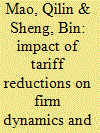| Srl | Item |
| 1 |
ID:
131492


|
|
|
|
|
| Publication |
2014.
|
| Summary/Abstract |
Among scholars, delegation of power to the US president in 1934 is widely believed to have been a necessary requisite for tariff reductions in ensuing years. According to conventional wisdom, delegation to the president sheltered Congress from constituent pressure thereby facilitating the opening of the US economy and the emergence of the United States as a world power. This article suggests a revision to our understanding of just how that occurred. Through a close study of the US tariff schedule between 1928 and 1964, focusing on highly protected products, we examine which products were subject to liberalization and at what time. After 1934, delegation led to a change in trade policy, not because Congress gave up their constitutional prerogative in this domain but because presidents were able to target the potential economic dislocation that derives from import competition to avoid the creation of a congressional majority willing to halt the trade agreements program.
|
|
|
|
|
|
|
|
|
|
|
|
|
|
|
|
| 2 |
ID:
156465


|
|
|
|
|
| Summary/Abstract |
This paper investigates the impact of trade liberalization on firm dynamics and productivity in the context of dramatic tariff reductions after China's accession to the WTO, and how this impact varies across regions with different marketization levels. Our results show that (a) on average, output tariff reductions tend to reduce firm entry rate and increase firm exit rate, while input tariff reductions help to increase both firm entry rate and exit rate, furthermore, regional marketization strengthens the impact of trade liberalization on firm dynamics; (b) trade liberalization exerts greater impact on the likelihood of exit for the least productive firms while it tends to reduce the probability of exit for the more productive firms, with regional marketization strengthening such a reallocation process of trade liberalization; (c) firm dynamics effect contributes approximately 43% of the growth of productivity, and it (especially the firm exit effect) is an important channel through which trade liberalization fosters productivity growth, and domestic market reform is found to strengthen such an impact.
|
|
|
|
|
|
|
|
|
|
|
|
|
|
|
|